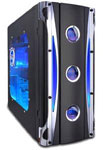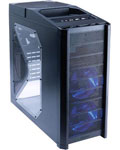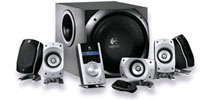Displays, Cases and Peripherals
| Base High-End Case and Accessories |
| Hardware |
Component |
Price |
Rebates |
| Display |
Acer AL2216Wbd 22" 5ms 1680x1050 |
$250 |
- |
| Case |
Apevia Aspire X-Cruiser |
$59 |
- |
| Power Supply |
Corsair CMPSU-620HX |
$126 |
- |
| Keyboard and Mouse |
Microsoft Comfort Curve 2000 with Optical Mouse |
$28 |
- |
| Speakers |
Creative I-Trigue 3300 |
$73 |
- |
| Total |
$536 |
$536 |
The monitor chosen as a minimum for the high-range systems is the
Acer AL2216Wbd. The 22" display has a 5ms response time and a resolution of 1680x1050, and while our review found that it wasn't competitive in terms of overall quality with most of the 24" LCDs, it's hard to argue with the significantly lower price. Regular readers of the Guide section of AnandTech will recognize this monitor as a frequent selection during the past few guides, and also notice that the price has dropped significantly on this model.
 |
Apevia is generally known as a component-brander, rather than a manufacturer, whose products typically target the value segment. The Aspire X-Cruiser case is, accordingly, a steel case, but it has lots of interesting embellishments. The clear side window, fan speed controller, fan speed indicator, and blue LEDs provide a lot of value compared to more well-known cases. Airflow is handled by two 80mm fans. Depending on your personal tastes, you may or may not like this case, but there are plenty of people that simply view the case as something to hold the rest of the components and for such users the Aspire X-Cruiser is a nice fit. Note that this case is an entry-level recommendation - if you are targeting this segment, you have more than ample choices to ensure that you get one that fits your needs.
The Corsair CMPSU-620HX is a solid offering from a company long known for providing excellent power supplies. Claiming an 80% efficiency rating and sporting three 12V rails rated at 18A, this power supply handles all hardware recommended in this Guide without issue at stock speeds. Overclockers (especially on quad core systems) and water-coolers, however, should look to the larger PSU offerings to ensure system stability. Airflow is provided by a bottom-mount 120mm fan. The Corsair power supplies are rebranded SeaSonic units, so if you prefer a SeaSonic S12 (or can find it for less money) the two are essentially the same.
 |
For the entry level speaker selection, we turn to Creative Labs. Creative's products run the gamut from entry-level to enthusiast, with a focus on PC gaming. The C44-6004, while not quite the pinnacle of Creative's effort, provides gamers with a solid audio environment, especially at the given price point. The Creative features entry-level 7.1 sound. Logitech's X-530 and X-540 are as usual viable alternatives in this price bracket. Any speakers selling for under $100 are definitely more midrange rather than high-end, but for a lot of people that's more than enough.
| Mainstream High-End Case and Accessories |
| Hardware |
Component |
Price |
Rebates |
| Display |
Dell UltraSharp 2407WFP |
$569 |
- |
| Case |
Antec Nine Hundred |
$115 |
- |
| Power Supply |
PC Power Silencer 750 Quad |
$200 |
- |
| Keyboard and Mouse |
Microsoft Natural Keyboard and 5000 Optical Mouse |
$61 |
- |
| Speakers |
Logitech Z-5300e |
$145 |
- |
| Total |
$1090 |
$1090 |
Most users either love or hate the Antec Nine Hundred case. The appearance of this steel mid-tower offering is something that has yet to be imitated by a competitor (draw what conclusions you will), but it's impossible to argue against this being a hardcore case. Four fans, including a 200mm behemoth at the top, ensure that airflow is more than adequate for even the most demanding of components. USB, FireWire, and audio ports for the case sit at the top, which makes a lot of sense, given that cases are usually on the floor.
An upgraded high-end solution deserves a larger display, and the Dell UltraSharp 2407WFP fills the need. Staying true to its name, Dell offers this 1920x1200 panel with virtually the same specifications as competing designs from Samsung (
244T) and others, but at a significantly lower price point. The 3 year warranty seals the deal.
The power supply also gets an upgrade for this package, making a fairly large jump up to the PC Power Silencer 750 Quad. This power supply is built to perform, with the capability of delivering a full 60A on its single 12V rail. At $195, it is a premium level component to be sure - but at this level, the additional cash outlay eliminates any concerns of power instability in our high-end system. The inclusion of four PCI-E 6-pin power adapters will definitely work well with the SLI 8800 GTX configurations.
Finally, the sound system makes the jump into the land of THX, with the Logitech Z-5300e package. The silver accents on the speakers are themselves another example of styling which provokes either a love-or-hate reaction; however, the sound quality from the system (particularly the subwoofer) places the audio aspect of these components squarely into the "enthusiast" category.
| Ultra High-End Case and Accessories |
| Hardware |
Component |
Price |
Rebates |
| Display |
Samsung 305T 30" 2560x1600 |
$1331 |
- |
| Case |
Kandalf VD4000BWS Liquid Cooled |
$270 |
- |
| Power Supply |
OCZ POWER GAMER OCZ1010GXSSLI |
$251 |
- |
| Keyboard and Mouse |
Logitech G15 Gaming Keyboard and G5 Mouse |
$110 |
- |
| Speakers |
Logitech Z-5500 |
$233 |
- |
| Total |
$2195 |
$2195 |
Yes, the
Dell 30" 3007WFP usually can be found for a little bit less than the Samsung 305T in the Ultra High-End selection; however, the newer 3007WFP-HC costs a bit more. The Samsung 305T panel therefore gets the nod for the display device on our $5000 rig, as you also get two dual-link DVI inputs whereas the Dell LCDs only include one. Like all current 30" panels, this display features a native 2560x1600 resolution; every ounce of horsepower in our 8800 GTS/GTX SLI configurations will be put to the test. For those interested in the improved color gamut of the newer Dell LCD, we would also suggest taking a look at the
HP LP3065, which offers the same improved color gamut but also includes three dual-link DVI ports.
At the extreme end of the spectrum, a case with built-in liquid cooling makes a lot of sense, and the Thermaltake Kandalf is an excellent way to go. The VD4000BWS is a truly amazing case, with three 120mm fans and blue LEDs complementing the aforementioned liquid cooling. This case is a monster, with nine 5.25" bays and eight 3.5" bays (two external) housing whatever components a user could dream of throwing in. Considering many water-cooling solutions can cost several hundred dollars, the overall price of this case plus water-cooling kit is very attractive. If you would prefer to avoid water cooling altogether, the Cooler Master 830CM Stacker case is a strong alternative.
The power supply for the system gets another nudge to the OCZ Power Gamer 1010GXSSLI. Going a couple notches further than the PC Power unit, the 1010GXSLI sports four 20A 12V rails, which is enough to handle even the water-cooled SLI setup chosen for the most expensive systems in this Guide.
For those of us with $5000 (okay, $5328) to spend, the Logitech Z-5500 Digital system is the only way to go. A powerful subwoofer placed only a few feet from a gamer can't be anything but good, and you'll be hard pressed to resist playing with that LCD control panel. The total sound volume is impressive given the price, and only much more expensive (and larger) home theater equipment will really put these speakers to shame. You don't necessarily need speakers this loud... but you know you want it.
















69 Comments
View All Comments
rtrkudos - Tuesday, May 29, 2007 - link
You were wrong on the Dell 30" LCD. The newer HC model they ship now has a grey-to-grey of 8ms which is what matters for gaming. They never updated their website to the newer specs.JarredWalton - Tuesday, May 29, 2007 - link
I made some clarifications on the LCD selections. Having personally used both the old Dell 3007WFP and one of the new "high color" 30" LCDs, I'm pretty comfortable in saying that very few people would actually noticed the difference in practical use. I know I couldn't. Besides, the 3007WFP-HC actually costs $1500 as opposed to $1300.mostlyprudent - Tuesday, May 29, 2007 - link
While I very much enjoy Anandtech's Buyer's guides, I have noticed lately a disconnect between what is recommended in the Buyer's guides and what is reviewed in the other articles. For example, I do not think I have ever seen a review of the Samsung hard drives, yet they show up quite often in recent buyer's guides. Also, the Crucial Balistix used in the ultra high end system. Have we seen a review of these?My point is that if I were to go back through Anandtech motherboard, hard drive and memory reviews - pick out the best performers/editor's choice winners - I would come up with a very different system than what you recommend in Buyer's Guides.
If your goign to recommend a different motherboard, hard drive or memory from what your recent reviews have identified as the "cream of the crop," then give me some benchmarks or other details (not general statements) that demonstrate why.
Gary Key - Wednesday, May 30, 2007 - link
We will have the Samsung drives in a review in June. They are not the fastest drives per say in the benchmarks (close enough as not to matter in most applications) but they do offer a great combination of speed, low noise levels, and price per Gigabtye. I was throughly impressed with the latest 500GB model and thought it would be a good choice for a storage drive when matched with the Raptor. In regards to the Crucial DDR2 memory, we are finding it to be an excellent choice once again based on the price to performance ratios in early testing (easily doing DDR2-1140 at 4-4-4-12 timings with 2.25V on the P35 boards). By the way, both of these products were purchased and were not supplied to us for reviews. We do go out and buy components that we identify as being interesting for our readership. ;) Just wish we had the blog sections working so we could discuss/provide details quicker.
JarredWalton - Tuesday, May 29, 2007 - link
Most of the choices are made with input from the other editors. I know some of them (Wes and Gary) have at least done some preliminary testing with parts that are mentioned in this article. Gary specifically recommended the Samsung drives as being worthy of inclusion. The Ballistix RAM is (if I have this right) Micron D9, which makes it roughly the same as most of the other D9 RAM when it comes to running faster than the rated speed.Comdrpopnfresh - Tuesday, May 29, 2007 - link
In any of the first four situations in the article, would adding a third-party soundcard add any performance gains, or have better quality? Say you added an x-fi to the striker extreme. How does the onboard compare to what you'd get with the x-fi?JarredWalton - Tuesday, May 29, 2007 - link
Depends on if you're running XP or Vista and if you want to jump through hoops in Vista. At this point, I would rate a sound card as an optional accessory, pending fallout from the Vista update. I have to think that Vista is hurting Creative, since it sort of leveled the playing field.hubajube - Tuesday, May 29, 2007 - link
In the article:I thought the cache was the same and only the clock speed was different. Confused.
duploxxx - Tuesday, May 29, 2007 - link
yep indeed correct, so many readers and yet only few that notice this wrong statementThe 5600+ gets the nod over the more expensive 6000+ due to the favorable situation with AMD's on-die memory controller for this processor. The added cache of the 6000+ generally doesn't improve performance enough to warrant the extra money
the 5600 has 2mb cache and a 2800 clock
the 6000 has 2mb cache and a 3000 clock
main difference is current tdp 125W, will change in a few months to 89W, from that moment a 6000 will be a nice buy / competitor against e6600 unless you oc offcourse.
JarredWalton - Tuesday, May 29, 2007 - link
My bad - I got the 5400/5600 confused with the 6000 situation. I guess there's no "5800+" 512K 3.0 GHz part out there. :)